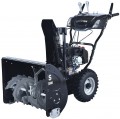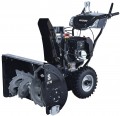Working width
The width of the strip of snow that the snow blower can clear in one pass. The larger the capture width, the fewer passes will be required to process the site, which is especially important on large areas. On the other hand, for processing small spaces, clearing individual paths, etc. significant width is not required (moreover, a “narrow” snow blower will pass more easily in a hard-to-reach place). The larger the capture width, the more powerful the engine, usually, ceteris paribus.
The most compact modern snow blowers have a working width of
less than 50 cm, these are mainly electric models of low power, although gasoline units are also found. A width of
50 – 60 cm can be called relatively small,
60 – 70 cm — medium, and in the largest models this figure
exceeds 70 cm.
Selectable locking differential
The ability to
unlock the differential is a mechanism that allows the wheels to rotate at different speeds.
This function is relevant only for self-propelled models (see "Design"). Many of these units do not have a differential at all, and if it is, it is locked by default — both of which mean that both drive wheels rotate at the same speed when powered by the engine. This has a positive effect on patency, but creates inconvenience when cornering: when turning, the wheel on the outside must rotate faster than the wheel on the inside. Unlocking the differential eliminates this inconvenience. On the other hand, a relatively small and light snow blower can also be deployed manually by disengaging the clutch and turning the unit on freely rotating wheels. Therefore, this function is provided only in powerful and heavy models, in which "manual" rotation is difficult.
Motor type
Model of the engine installed in the snow blower.
With this information, you can find detailed data on the engine — from official specifications to reviews, reviews and advice on specific nuances. In this way, you can evaluate how a snow blower with this particular engine will suit your needs.
Motor power
Snowblower motor power in horsepower.
The universal unit of power today is watts, but for petrol and diesel engines (see "Motor type"), the traditional designation in horsepower may also be given. 1 HP approximately equal to 735 watts.
The higher the motor power, the higher the performance of the snow blower, the better it handles with high dense snowdrifts and icy crust. However, more powerful engines consume more fuel, weigh more and cost more, and their use is not always justified. Detailed recommendations on choosing the optimal power for a specific situation can be found in special sources.
Motor power
Snowblower motor power in watts. This designation is used for all electric models; for units with an internal combustion engine (see "Motor type"), the designation in horsepower may also be given (see above).
The higher the motor power, the higher the snowblower's flow rate, the better it copes with high dense snowdrifts and icy crust. However, more powerful engines consume more fuel, weigh more and cost more, and their use is not always justified. Detailed recommendations on choosing the optimal power for a specific situation can be found in special sources.
Fuel tank volume
The amount of fuel that the snow blower tank can hold at one time. Knowing this figure, as well as fuel consumption (see above), you can easily calculate the approximate operating time on one gas station. However, manufacturers usually choose the volume so that the operating time reaches at least 2 – 2.5 hours, so in most cases you can not pay much attention to this parameter.

